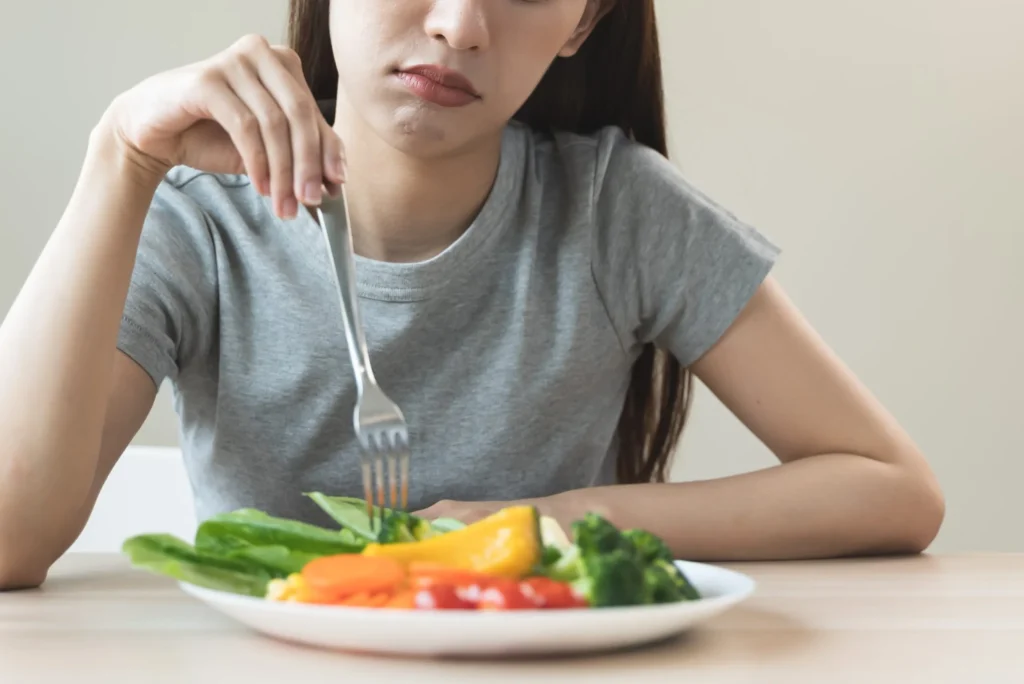At Paradigm Treatment, we work daily with families facing some of their hardest moments. When a teen struggles with both self-harm and eating disorders, parents often feel lost trying to understand how these two issues connect and what they can do to help. The truth is, these behaviors frequently appear together, and recognizing this connection is the first step toward getting your child the support they need.
Self-harm means deliberately hurting yourself to manage overwhelming feelings. Eating disorders like anorexia, bulimia, and binge eating reflect unhealthy patterns with food and body image. They might look like separate issues, but they’re often two sides of the same coin: different ways of expressing the same pain.
Table of Contents
- Why Self-Harm and Eating Disorders Occur Together
- Common Eating Disorder Effects on Teens
- Anorexia and Self-Harm in Teens
- Bulimia as Self-Harm: The Hidden Connection
- How Parents Can Support Their Teen
- When Professional Help Is Needed
- FAQs
- Conclusion
- Key Takeaways
- Sources
Why Self-Harm and Eating Disorders Occur Together
Why do these two behaviors show up together so often? The answer lies in what they accomplish for teens who feel overwhelmed.
Both self-harm and eating disorders serve similar psychological purposes. They’re ways of coping with emotions that feel too big to handle. They create a sense of control when everything else feels chaotic. And for many teens, they become forms of self-punishment rooted in feelings of not being good enough.
Several risk factors make teens more vulnerable to both conditions:
Low self-esteem creates a foundation where teens believe they deserve punishment or need to earn their worth through control over their bodies.
Past trauma leaves emotional wounds that teens may try to manage through physical pain or food restriction, translating psychological hurt into something more tangible.
Perfectionism drives impossible standards. When teens inevitably fall short, they may turn these behaviors inward as punishment.
Depression and anxiety amplify emotional pain and reduce healthy coping skills, making harmful behaviors seem like the only available relief.
These shared roots explain why treating one issue without addressing the other rarely leads to lasting recovery.

Common Eating Disorder Effects on Teens
The eating disorder effects that show up in teenagers extend well beyond changes in weight or eating habits. These conditions impact every aspect of a young person’s life.
The physical damage goes beyond weight changes. Malnutrition weakens the heart and organs, hormones fall out of balance, and the immune system falters. In severe cases, it’s life-threatening.
Emotionally, the impact cuts just as deep. Teens often feel numb or disconnected. Depression deepens, anxiety spikes around food and social situations, and in the worst cases, suicidal thoughts emerge. Learn more about teen depression treatment.
The ripple effects touch everything. Grades slip as focus fades. Friendships disappear when teens pull away from activities. Family tension builds around secrets and worry. The longer it goes on, the harder it becomes to just be a normal teenager.
Anorexia and Self-Harm in Teens
The link between anorexia and self-harm in teens shows how food restriction becomes another way to hurt yourself. It’s not really about weight. It’s about control and punishment.
These teens think in black and white. One slip-up feels catastrophic. The same perfectionism that drives extreme dieting also drives cutting or burning: both are ways to punish themselves for not measuring up.
When everything else feels out of control, restricting food or inflicting pain gives them something to manage. It doesn’t matter that it’s harmful. It’s theirs to control.
Here’s what makes this so dangerous: starvation changes your brain. It makes regulating emotions nearly impossible, which increases the urge to self-harm. And the emotional pain behind self-harm? It makes that inner critic even louder, demanding more restriction.
Bulimia as Self-Harm: The Hidden Connection
Bulimia as self-harm isn’t a metaphor. Purging physically damages the body. Vomiting erodes the esophagus and teeth. Laxatives wreck the digestive system. Compulsive exercise breaks down muscles and joints.
The emotional pattern looks identical to cutting. Binge, lose control, feel ashamed. Purge to punish yourself and grab back some sense of control. Then the shame from purging triggers the next binge. It’s a loop that feeds on itself.
Many teens with bulimia cut or hurt themselves in other obvious ways too. It’s all the same impulse: using physical pain to manage emotional overload.
The secrecy makes bulimia harder to spot. Weight might stay normal. Teens get good at hiding it, turning bathrooms into their private place to purge while keeping up appearances at dinner.
How Parents Can Support Their Teen
If you think your teen is struggling with both self-harm and disordered eating, how you respond matters.
Lead with concern, not accusations. Skip “Why are you doing this?” Try “I’ve noticed you’re struggling, and I’m worried. Can we talk?” You’re creating safety, not interrogating.
Watch for signs without becoming the hall monitor. Unexplained injuries, weight swings, baggy clothes in summer, bathroom trips after meals. Pulling away from friends, mood shifts, food secrecy, and over-exercising. Harsh self-talk, expressing worthlessness, and seeming checked out emotionally.
Don’t pile on shame. Your teen already feels awful about their behaviors. Parental disappointment usually drives them deeper into hiding, not toward help. Show them you see someone who’s hurting and deserves support, not someone who’s weak or broken.
Learn about what they’re going through. When you understand why these behaviors exist, you can respond with compassion instead of frustration. Check out our mental health resources to understand their experience better.
Take care of yourself. This is exhausting. Consider a parent support group or your own therapist to process your feelings and stay strong enough to help your kid.

When Professional Help Is Needed
Sometimes outpatient therapy isn’t enough.
Get professional help immediately if self-harm is escalating, weight loss is severe or causing medical problems, your teen mentions suicide, or outpatient treatment hasn’t helped.
Residential programs provide the intensity needed when behaviors are deeply entrenched or medically dangerous. You get 24/7 medical and psychiatric care, intensive therapy that digs into root causes, constant support to interrupt harmful patterns, and integrated treatment for depression, anxiety, or other co-occurring issues.
Our residential treatment for teens addresses the whole person, not just symptoms. Individual therapy helps teens understand what’s driving their behaviors. Group sessions break isolation and teach healthy coping. Family therapy rebuilds relationships and equips you to support recovery. Medical and nutrition care ensures physical healing happens alongside emotional growth.
The structured environment removes home triggers. Your teen can focus completely on recovery without school stress, social drama, or family dynamics that may have contributed to their struggles.
FAQs
Why do eating disorders and self-harm often occur together?
They’re both unhealthy ways to cope with overwhelming emotions. Both create a sense of control, release pressure, and express pain that feels impossible to say out loud. The same issues, like trauma, depression, low self-esteem, and perfectionism, increase risk for both.
What signs should I watch for?
Look for patterns, not one-off incidents. Weight changes, unexplained injuries, long sleeves in summer, and bathroom trips after eating. Obsession with food or exercise, increased secrecy, pulling away from friends, and mood swings. Brutal self-criticism, talking about worthlessness, and seeming emotionally flat.
Can recovery address both conditions at once?
Yes, and it needs to. Treating just one while ignoring the other usually leads to relapse because the underlying emotional struggles stay unresolved. Integrated treatment recognizes the connection and helps teens build coping strategies that work for everything they’re dealing with.
How should parents respond if they suspect both self-harm and an eating disorder?
Stay calm, even though you’re scared. Skip the blame and anger. Say something like, “I’ve noticed some things that worry me, and I care about you too much not to talk about this.” Don’t wait, hoping it’ll go away. Call a mental health professional who works with teens for an evaluation. Earlier help means better chances for a full recovery.
Conclusion
The overlap between self-harm and eating disorders in teenagers isn’t random. These behaviors are deeply connected responses to emotional pain that feels unbearable. For parents, discovering that your teen is struggling with both can feel overwhelming. But understanding this connection is powerful. It means you can seek integrated care that addresses the root causes rather than just individual symptoms.
Early intervention makes a significant difference in outcomes. The longer these patterns continue, the harder they are to change. But with treatment and family support, recovery is absolutely possible.
At Paradigm Treatment, we’ve worked with hundreds of families in this difficult situation. We’ve seen teens who seemed lost in their struggles find their way back to health, happiness, and hope. You don’t have to go through this alone. Reaching out for help isn’t giving up: it’s the most loving and courageous thing you can do for your child.
Key Takeaways
- Eating disorder effects extend far beyond physical health, impacting emotional well-being, relationships, and increasing vulnerability to self-harm and depression
- Anorexia and self-harm in teens frequently stem from the same psychological roots: perfectionism, need for control, and self-punishment for perceived inadequacy
- Mental health professionals increasingly recognize bulimia as self-harm due to the physical damage and psychological punishment inherent in the binge-purge cycle
- Parents should remain alert for combinations of warning signs, including physical changes, behavioral shifts, and emotional distress, and trust their instincts when something feels wrong
- Paradigm Treatment provides comprehensive, integrated care specifically designed for teens facing the dual challenges of self-harm and eating disorders, treating the whole person rather than isolated symptoms
Contact us today to get started.
Sources
- Ambler, F., Hill, A. J., Willis, T. A., Gregory, B., Mujahid, S., Romeu, D., & Brennan, C. (2025). How Do the Psychological Functions of Eating Disorder Behaviours Compare with Self-Harm? A Systematic Qualitative Evidence Synthesis. Healthcare (Basel, Switzerland), 13(15), 1914. https://doi.org/10.3390/healthcare13151914
- Chen, L.-C., Bai, Y.-M., Tsai, S.-J., Cheng, C.-M., & Chen, M.-H. (2025). Eating disorders, psychiatric comorbidities, and suicide. Journal of Affective Disorders, 382, 290-295. https://doi.org/10.1016/j.jad.2025.04.090
- Eisenman, S. R., Jackson, I., Hudson, L. D., & Vázquez-Vázquez, A. (2025). The Co-Occurring Prevalence of Non-Suicidal Self-Injury and Disordered Eating Among Adolescents and Young Adults: A Systematic Review. The Journal of adolescent health: official publication of the Society for Adolescent Medicine, 76(6), 985–994. https://doi.org/10.1016/j.jadohealth.2025.01.016





 October 15, 2025
October 15, 2025 Reading Time: 9m
Reading Time: 9m